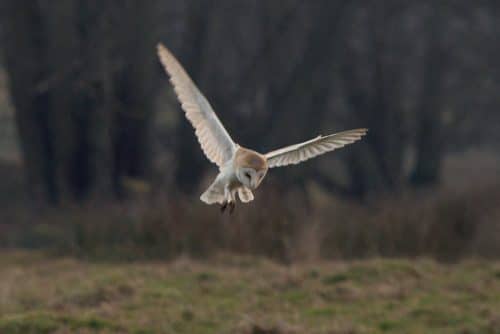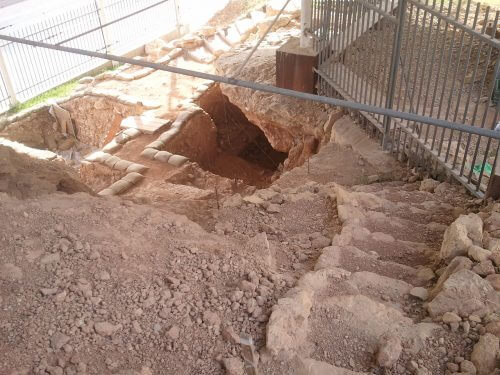A diet of respiration from hundreds of thousands of years ago allows researchers to reconstruct what the environment looked like in which the ancient man lived near the head of the eye

By Orlev Tsekh, Zveta, Science and Environment News Agency
It's not easy being a bird. The need to be light enough to fly, even after a good meal, led certain birds to develop an ingenious invention: chastity. Everything that is not digested quickly enough and has a low nutritional value - such as fur, teeth, bones and the like - is vomited by the bird into a compacted mass called tsnifa. Sounds more disgusting than impressive? Remember that apart from birds, no one knows how to perform this magic, not even us.
Now, researchers are learning to take advantage of hundreds of thousands of year-old tilings found in a magic cave near Rosh Ha'Ain to reconstruct what the ancient environment at the site looked like. The remains of the small mammals found in Tsenofit, which include a golden squirrel and a species of sleeper that has been extinct in Israel for a long time, tell the story of the ancient environment in the area - and complete the prehistoric puzzle regarding the ancient man who lived in Merat Kesem.
Hedgehog shells
Or Komai, from the Department of Zoology at Tel Aviv University, came to investigate Merat Kesem out of his interest in paleoecology: the study of prehistoric living environments. "In my opinion, an ecosystem exists not only in space, but also in time. If you want to understand how the ecosystem you are studying will be affected by changes, such as global warming, you need to know its past," he says. Komai's research, which is part of his doctoral thesis, allows a new look at prehistory - this time from a bird's eye view.
In Kesem Cave, which is located near Rosh Ha'Ein and was discovered in 2000 during the works for the expansion of Highway 6, remains of the ancient man of the Ashlo-Yebroid culture were found, approximately from 400 to 220 thousand years before our time. In addition to the remains of human activity, such as flint tools and the remains of bonfires, an impressive variety of bones is found on the site: some are remnants of the meals of the ancient man, which have undergone scorching and cutting, and some are bones of small mammals - remnants of ancient courtships that arrived at the site.
A basic assumption in paleoecology is that each animal has a characteristic habitat, therefore when many bones of animals of a certain species are found at an archaeological site, it can be assumed that the typical environment of that animal existed at that time. But before he could approach the reconstruction of the living environment, Komai faced a very complex task: the remains of the animals found in the tsnipots come from birds of different species, each of which has specific culinary preferences. How do you tell which crest comes from which bird, and more importantly, how do you know which crests best represent the ancient environment?
As a first step, in order to know how to distinguish between the different tsinofts, Komai turned to the Zoological Garden at Tel Aviv University for help. The mice eaten by the nocturnal raptors in the garden soon became rascals of known origin; All the bones of the mice were examined in the laboratory to understand how they were preserved after passing through the raptor's stomach. And so, the unique pattern of cracks that each raptor left in the bones it ate became an accurate index, which makes it possible to identify the type of raptor by the bones of the mice found in the nest.

In a second step, Komai is required to understand to what extent the diet of different birds reflects the diversity of mammals in the Mediterranean region of the Land of Israel. To this end, Komai collected raptors from around the country of known origin, and tried to understand which raptor has the broadest "taste". From the analysis of the chastity, it turned out that the unique taste of the raptors depends to a large extent on their size: a small raptor, like the Ruined Cup, enjoys small prey such as mice and insects; Whereas large raptors had a more varied taste that included prey of a variety of sizes. The man excelled at particularly challenging prey - hedgehogs, which he eats from below and leaves behind only "shells" covered in thorns. But the prize for the most representative bird was picked up by the pufferfish without effort: compared to other raptors, an average of 97 percent of mammals was found in the pufferfish's purity, which consisted of a variety of characteristics of the mammals in the field.
Behavior of ancient hunters
Luck played in Kumai's favor: the analysis of the ancient sphinxes revealed that they could only belong to an Anasma or Lilith, which is also greatly influenced by the culinary supply in the habitat. Now that he has accurate information about the chicken's gills that are placed before him, Kumai is required to do the difficult task: using them to reconstruct the environment in which those prehistoric mammals lived that became the lunch of breathing or nocturnal animals.
In Israel's Mediterranean region, the diversity of small mammal species is mainly influenced by the density of vegetation. Not the winter temperatures, not the wind regime, not the type of soil - what determines to the greatest extent where each species of mammal will live is the nature of the vegetation. For example, yellow-necked woodpeckers, common gophers and bar hamsters will prefer dense woodland, while barbarians and marions will choose open environments. More familiar rodents, such as mice, did not show a specific preference, and rats actually like pine forests.
In order to make sure that respiration does provide reliable evidence of the density of vegetation, Komai compared data from 70-year-old tsinofts to the density of vegetation in the Land of Israel, as it appears from maps of the British Mandate. "Today I can tell you which rodents there are from the lower Galilee to the Judean plains, according to the purity of breathing," Komai says. "But when I was at the beginning, I met a field person who said there was no point in doing the research. He claimed that everywhere in the Land of Breathing they will eat the same thing: that they hunt in open areas, even if they nest in the forest. I have shown that this is not true. There are significant differences between the purity of ospreys that nest in the forest and ospreys that nest in open areas."
The next step was to reconstruct the surroundings of the ancient Kesem Cave, from the Ashlo-Hebrodic period. The ancient tools found by the archaeologists at the site and the intensive use of fire indicate a significant behavioral change that took place at that time. This change, which also led to a biological change in the evolution of man, can testify to a new type of man in our region 400 thousand years ago.
Environmental reconstruction gives further context to this mysterious intermediate stage in human evolution. According to one theory, at that time many large animals, such as elephants, became extinct due to hunting. Man, in his misery, moved on to hunting donkeys, reddish deer living in the woods and even turtles. Hunting is evidenced by many cut and charred bones discovered in the cave.
Elephants were a calorie bomb for early man; Researchers from Tel Aviv University calculated and found that in terms of calories, one elephant is worth at least 80 donkeys. According to Prof. Ran Barkai, who excavated and studied the Magic Cave, the disappearance or extinction of the elephants pushed humans to adapt to the new environment, both biologically and culturally - and so in order to extract more calories from the hippos, humans began to use fire to roast the meat.
Unlike elephants, the donkeys prefer the tangled forest as a habitat. But surprisingly, Kumai's research shows that the ancient Magic Cave environment was not a forest at all, but an open grassy landscape. A very high percentage of Nevarni bones, which dominate open areas, showed that a Mediterranean forest did not exist at all in most of the area, but only in small spots on the edges.
Were the ancient hunters now forced to cross vast grassy plains to reach the cool shade of the woods and hunt a juicy donkey? The answer, perhaps, in the next study. Until then, you can use the method developed by Kumai to check other sites as well, and learn about our past - and the future.

One response
Why can't you bring an article without mentioning global warming?
The article deals with the findings from the times of the ancient man and before him periods that are quite a long time before the industrial revolution and global warming even started.
But it doesn't matter if there is a connection, there is no connection...
Every article on this delusional website "Angle" wanted to be related to global warming...